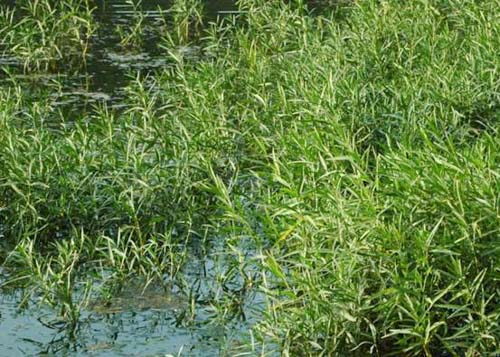Water Willow
In the spring, newly emerging water willow (Justicia americana) creates excellent vertical structure for fast rolling a spinnerbait or fishing a fluke or senko.

Seasonal Techniques
Spring—Native water willow emerges from seed and from previously existing underground roots (rhizomes) in early spring. Newly emerging water willow creates excellent vertical structure for fast rolling a spinnerbait or fishing a fluke or senko.
Summer—Water willow rapidly expands through rhizomes. The plants will begin to produce a white and violet flower in early summer and will continue to flower through fall. As stands become thicker, invertebrates and baitfish will congregate in the vertical structure of water willow. Fish a shallow crankbait or swimbait around edges and in shoreline pockets of waterwillow. Transitions between water willow and other species or structure are also productive.
Fall—Plants will begin to die back and drop seed into the water column in fall. Fishing edges and pockets will remain productive through fall. Run a buzzbait parallel to the edge formed by water willow, or work a spinner bait back into water willow stands.
Winter—Very little water willow will be present in winter, so targeting this species should be avoided until spring.
Habitat Value
Fish—Shoreline habitat for invertebrates can be created by water willow, thus attracting baitfish and other species that bass readily feed on.
Waterfowl—Water willow benefit to waterfowl is considered minimal.
Identifying Features
What It Looks Like—Leaves are opposing around the stem and flowers are bi-color violet and white.
Where to Find It—Water willow can grow in a wide range of sediment along the shoreline, often stretching out as deep as five feet of water. Water willow has even been known to grow within rocky substrate.
Max Depth—0 to 5 feet
Similar Species—Water willow may resemble other shoreline species, but is very widespread and much more common that most.
Drawbacks
Water willow has caused some issues with water use and management is sometimes needed. Cost to manage: $$ out of $$$$$.
Contact Us
We're always looking for more information about aquatic plants on TVA reservoirs. Let us know where and what you see, and send us your photos. Email us.